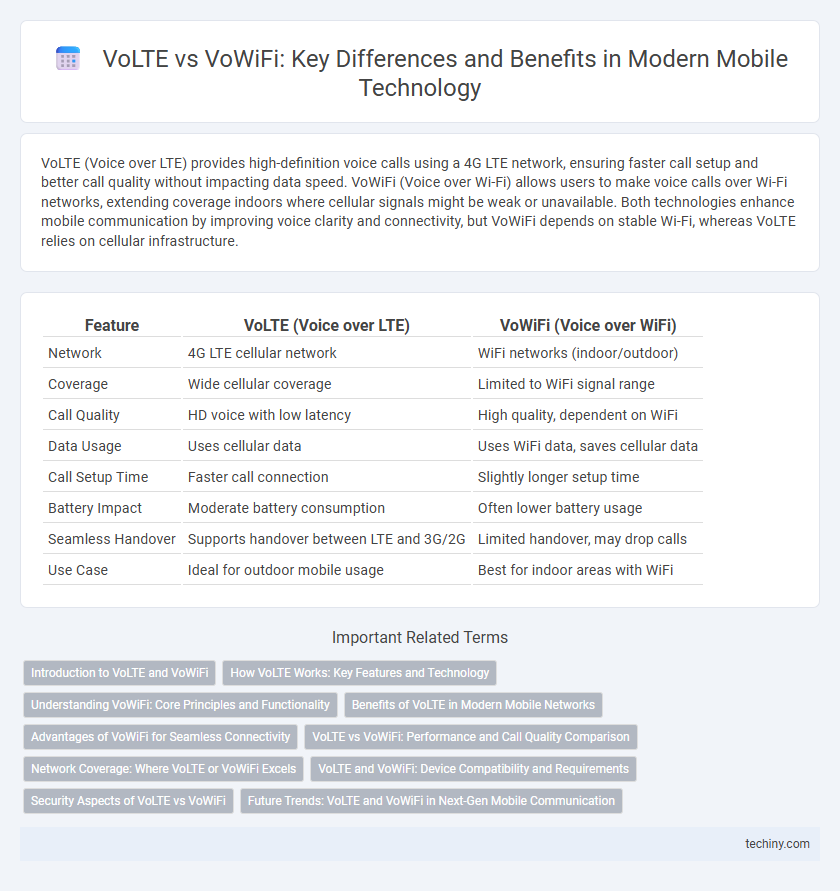VoLTE (Voice over LTE) provides high-definition voice calls using a 4G LTE network, ensuring faster call setup and better call quality without impacting data speed. VoWiFi (Voice over Wi-Fi) allows users to make voice calls over Wi-Fi networks, extending coverage indoors where cellular signals might be weak or unavailable. Both technologies enhance mobile communication by improving voice clarity and connectivity, but VoWiFi depends on stable Wi-Fi, whereas VoLTE relies on cellular infrastructure.
Table of Comparison
| Feature | VoLTE (Voice over LTE) | VoWiFi (Voice over WiFi) |
|---|---|---|
| Network | 4G LTE cellular network | WiFi networks (indoor/outdoor) |
| Coverage | Wide cellular coverage | Limited to WiFi signal range |
| Call Quality | HD voice with low latency | High quality, dependent on WiFi |
| Data Usage | Uses cellular data | Uses WiFi data, saves cellular data |
| Call Setup Time | Faster call connection | Slightly longer setup time |
| Battery Impact | Moderate battery consumption | Often lower battery usage |
| Seamless Handover | Supports handover between LTE and 3G/2G | Limited handover, may drop calls |
| Use Case | Ideal for outdoor mobile usage | Best for indoor areas with WiFi |
Introduction to VoLTE and VoWiFi
VoLTE (Voice over LTE) enables high-quality voice calls over 4G LTE networks, providing faster call setup and improved voice clarity compared to traditional voice services. VoWiFi (Voice over Wi-Fi) allows users to make voice calls using Wi-Fi networks, extending coverage in areas with limited cellular signal. Both technologies enhance mobile communication by leveraging different network infrastructures to optimize call reliability and user experience.
How VoLTE Works: Key Features and Technology
VoLTE (Voice over LTE) enables high-definition voice calls using the LTE network by transmitting voice as data packets over IP, bypassing traditional circuit-switched networks. Key features include superior call quality with HD voice, faster call setup times, and simultaneous voice and LTE data use. The technology relies on the IMS (IP Multimedia Subsystem) framework and supports seamless handoffs between LTE and Wi-Fi networks for consistent connectivity.
Understanding VoWiFi: Core Principles and Functionality
VoWiFi (Voice over Wi-Fi) enables voice calls over Wi-Fi networks, complementing traditional cellular services by leveraging internet connectivity for enhanced indoor coverage and call quality. It operates by routing voice traffic through IP packets over Wi-Fi, reducing reliance on cellular towers and improving connectivity in areas with weak mobile signals. VoWiFi integrates seamlessly with VoLTE (Voice over LTE), ensuring smooth call handoffs and consistent user experience across cellular and Wi-Fi networks.
Benefits of VoLTE in Modern Mobile Networks
VoLTE (Voice over LTE) significantly improves call quality with HD voice, offering clearer and more natural conversations compared to traditional 3G or VoWiFi calls. It enhances network efficiency by using the LTE data network for voice traffic, leading to faster call setup times and reduced latency. VoLTE supports simultaneous voice and data transmission, allowing users to browse the internet or use apps without call interruptions, making it a vital technology for modern mobile networks.
Advantages of VoWiFi for Seamless Connectivity
VoWiFi enhances seamless connectivity by enabling voice calls over Wi-Fi networks, ensuring reliable communication in areas with poor cellular coverage. It reduces dropped calls and extends service availability indoors, where traditional cellular signals often weaken. By leveraging existing Wi-Fi infrastructure, VoWiFi also helps optimize network traffic and improve call quality without relying solely on cellular towers.
VoLTE vs VoWiFi: Performance and Call Quality Comparison
VoLTE offers superior call quality and lower latency by utilizing the LTE network for voice transmission, ensuring clearer audio and faster call setup times compared to VoWiFi. VoWiFi relies on Wi-Fi networks, which can vary in stability and speed, potentially causing fluctuations in call quality and intermittent connectivity. Network conditions and coverage ultimately influence the performance differences, with VoLTE proving more reliable in outdoor and cellular-dense environments, while VoWiFi excels indoors where strong Wi-Fi signals are available.
Network Coverage: Where VoLTE or VoWiFi Excels
VoLTE excels in areas with strong 4G LTE network coverage, providing high-quality voice calls with low latency and seamless handoffs. VoWiFi shines in indoor environments or locations with weak cellular signals, leveraging Wi-Fi networks to ensure uninterrupted voice connectivity. Both technologies complement each other by extending reliable voice services across diverse network conditions.
VoLTE and VoWiFi: Device Compatibility and Requirements
VoLTE requires devices to support LTE bands and IMS (IP Multimedia Subsystem) for seamless voice over LTE networks, ensuring high-definition voice quality and low latency calls. VoWiFi depends on compatible Wi-Fi hardware and software integration, alongside carrier support for IP routing through wireless networks, allowing voice calls in areas with poor cellular coverage. Both technologies rely on firmware updates and operator certification to optimize performance and compatibility across various mobile devices.
Security Aspects of VoLTE vs VoWiFi
VoLTE (Voice over LTE) utilizes the robust security framework of LTE networks, including strong encryption protocols like IPsec and EPS-AKA authentication, ensuring enhanced data integrity and protection against interception. VoWiFi (Voice over Wi-Fi) relies heavily on the security of the underlying Wi-Fi network, which can vary significantly, making it more vulnerable to risks such as man-in-the-middle attacks unless robust WPA3 encryption and secure tunneling methods like IPSec or TLS are implemented. Effective security in VoWiFi requires stringent Wi-Fi network configurations and carrier-grade security measures to match the inherent protections of VoLTE.
Future Trends: VoLTE and VoWiFi in Next-Gen Mobile Communication
VoLTE and VoWiFi will play pivotal roles in next-generation mobile communication by enhancing network efficiency and expanding coverage, especially in indoor and underserved areas. Advances in 5G integration and seamless handover technologies will enable higher voice quality, lower latency, and improved user experience across heterogeneous networks. Industry adoption of AI-driven network optimization promises to further optimize VoLTE and VoWiFi performance, ensuring robust connectivity and supporting emerging IoT applications.
VoLTE vs VoWiFi Infographic

 techiny.com
techiny.com